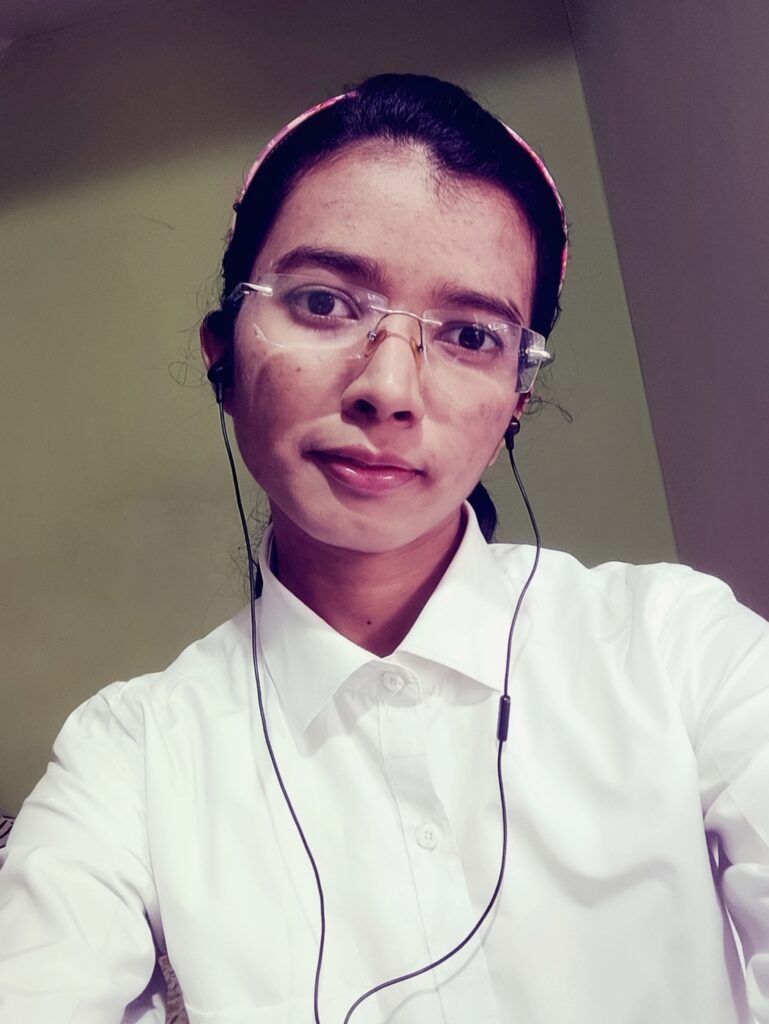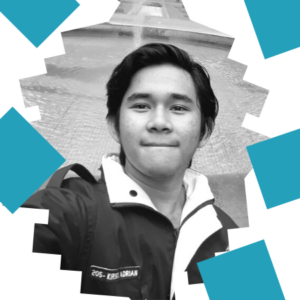
Home » Success Story- 15194
COMPANY:
manufacturer and supplier of IoT products
An Indian woman majoring in electronic communication engineering. The graduation project is about the classification of brain tumors using deep learning and developing end-to-end apps that allow doctors to detect tumors easily. Her dream to participate in the Tokyo Olympics for the shooting was the reason that she developed an interest in Japan. Her dream didn't come true because of her injury, but she's currently studying Japanese with the aim of finding a job in Japan. She is a hard worker and has a tenacious spirit.
Profile
COUNTRY / REGION
India
SEX
Female
UNIVERSITY
Savitribai Phule Pune University
SPECIALIZATION
Electronics and Telecommunication
ACADEMIC LEVEL
Bachelor
MESSAGE
First of all, I prefer to find out new things, and once when I was a high school student, I examined Japanese food in one of my presentation topics. After a few years, I saw Japanese documentaries, Japanese technology, Japanese Drama, etc. and I really liked Japanese culture.
When I was a 2nd year Engineering student, I got to know about the FAST OFFER International Program (formerly Study Go Work JAPAN Program) through a seminar. A job opportunity in Japan right after graduation appeared to be the spark that urged me to start learning Japanese. After initial lectures in Japanese classes, my interest in Japan and Japanese culture grew a lot.
The idea of “Life in Japan”, gave me my dream goal of working in Japan.
I can’t really express the happiness in words because there are tons to inform but I feel this is often a life-changing point on behalf of me. Throughout my journey, all of the teachers at the Japanese Language Program inspired and supported me.
After completing my JLPT N3, I became eligible to apply for interview rounds for Japanese companies. For that, I was supposed to clear a mock interview round which our class sensei took, then another interview with my ASIA to Japan mentor Kawai san. She really helped me a lot throughout this procedure. After document screening and PR video, I was finally able to apply for interview rounds. At first, I was able to give the first round to one company but got rejected in the first round, which was a coding round.
After a long wait of around 6 months, I got the opportunity to interview for IoT products producing and supplying company. I was totally scared as it was my first time giving an interview for a Japanese company. But my mentor-san really helped me throughout the process, giving me a better understanding of how to prepare simple, easy-to-understand presentations. He helped me correct the mistakes that I used to make and how I presented my appeal points. After clearing the First round and web aptitude test, I gave the final interview. Result got delayed due to the Golden week holidays but it was worth waiting for.
When I learned that I had successfully passed the interview on my very first try, it was a dream come true. It was something I had been focusing on for about 2.5 years. My sensei and my mentors were equally happy about the positive results and my future.
I am deeply grateful for ASIA to JAPAN’s guidance, encouragement, resources, and time spent for me to help me accomplish this dream. This wasn’t possible without support from all of them who were there with me throughout this journey, my family, sensei, mentors, and friends.
Thank you to ASIA, JAPAN, and my mentors for allowing me to participate in this amazing life-changing opportunity!
I am looking forward to starting a new chapter of my life in Japan very soon!
When I was a 2nd year Engineering student, I got to know about the FAST OFFER International Program (formerly Study Go Work JAPAN Program) through a seminar. A job opportunity in Japan right after graduation appeared to be the spark that urged me to start learning Japanese. After initial lectures in Japanese classes, my interest in Japan and Japanese culture grew a lot.
The idea of “Life in Japan”, gave me my dream goal of working in Japan.
I can’t really express the happiness in words because there are tons to inform but I feel this is often a life-changing point on behalf of me. Throughout my journey, all of the teachers at the Japanese Language Program inspired and supported me.
After completing my JLPT N3, I became eligible to apply for interview rounds for Japanese companies. For that, I was supposed to clear a mock interview round which our class sensei took, then another interview with my ASIA to Japan mentor Kawai san. She really helped me a lot throughout this procedure. After document screening and PR video, I was finally able to apply for interview rounds. At first, I was able to give the first round to one company but got rejected in the first round, which was a coding round.
After a long wait of around 6 months, I got the opportunity to interview for IoT products producing and supplying company. I was totally scared as it was my first time giving an interview for a Japanese company. But my mentor-san really helped me throughout the process, giving me a better understanding of how to prepare simple, easy-to-understand presentations. He helped me correct the mistakes that I used to make and how I presented my appeal points. After clearing the First round and web aptitude test, I gave the final interview. Result got delayed due to the Golden week holidays but it was worth waiting for.
When I learned that I had successfully passed the interview on my very first try, it was a dream come true. It was something I had been focusing on for about 2.5 years. My sensei and my mentors were equally happy about the positive results and my future.
I am deeply grateful for ASIA to JAPAN’s guidance, encouragement, resources, and time spent for me to help me accomplish this dream. This wasn’t possible without support from all of them who were there with me throughout this journey, my family, sensei, mentors, and friends.
Thank you to ASIA, JAPAN, and my mentors for allowing me to participate in this amazing life-changing opportunity!
I am looking forward to starting a new chapter of my life in Japan very soon!

FINAL YEAR PROJECT
1.研究題名:ディープラーニングを用いた脳腫瘍MRI画像の分類
2.背景と目的:
今日、私たちはほとんどすべての情報をオンラインとデジタルで使用しています。
このプロジェクトの目的は脳腫瘍の早期発見に役立ち患者の命を救う可能性を高め全体の診断時間も短縮することです。脳腫瘍は、神経膠腫(Glioma)、髄膜腫(Meningioma)、脳下垂体腫(Pituitary)、無腫瘍(No Tumor)の4種類に分類されます。このプロジェクトの後、エンドツーエンドのアプリケーションを開発する予定です。このWebアプリケーションを利用して、脳神経外科医が安価に脳腫瘍の種類を簡単に分類することと腫瘍を検出することです。
3.実施内容:
脳腫瘍の分類は、畳み込みニューラルネットワーク(CNN)モデルを使用して実装できます。また、トレーニングとテストのために、約8750のMRIからなるラベル付きデータセットを参照しました。
最初の段階では、データセット内のMRIの数を増やすためにデータ-アグメンテイシャンを使用しました。その後、データセットを80%と20%に分割し、トレーニング用とテスト用に分けました。
そして、畳み込み2D (Convolutional 2d Layer)、最大プーリング層(Max Pooling Layer)、完全連結層( Fully Connected Layer)、 などの様々な層からなるCNNアーキテクチャを使用しました。 具体的には、Relu activation unit、ADAM optimizer、Softmax classifier を使用しました。ソフトマックス分類器層の後で望ましい結果を得ることができます。私たちのプロジェクトではVGG16, CONVNETとEFFICIENTNET B0 CNNモデルを利用しています。これらのモデルについて精度を検討し、最終的に最適なモデルを選んで実装しています。
1) 最初にディープラーニング、djangoを使ったWebアプリケーション開発などを勉強しました。
2) 脳腫瘍の3つのデータセットをkaggle.comのウェブサイトから収集しました。
3)2値分類モデルを実装し、様々なモデルとその精度を検討した。VGG16とINCEPTION V3 とRESNET50の各モデルは、それぞれ95.20%、92.1%、95.90%の精度を示した。
4)脳腫瘍の多重分類のために,VGG16モデルを学習させた。その精度と損失グラフを調査しました。VGG16モデルは81.77%精度を示した。
5)モデルの精度を上げるための方法を検討しました。また、学習させるMRIの枚数を増やし、画素サイズとエポック数を増やすことで、モデル全体の精度を向上させました。VGG16モデルは96.27%精度を示した。
6)djangoを使ったWebアプリケーションを実装しています。
4.結果:
入力MRIは、神経膠腫(Glioma)、髄膜腫(Meningioma)、脳下垂体腫(Pituitary)、無腫瘍(No Tumor) の4種類に分類されます。現在の研究では90%までの精度を示しています。
様々なモデルを用いてテスト精度を確認し、最終的なモデルではVGG16モデルは96.27%の精度を示した。CONVNETとEFFICIENTNET B0モデルを学習しています。TensorFlow keras、ジュピターノートブックを使用して、システムの実コードを作成中です。
5.学んだこと、今後の課題:
医療現場におけるCADシステムの重要性を学びました。最初は、ディープラーニングの詳細について学び始めました。また、CNNアーキテクチャの各レイヤーがどのように機能するかを理解した。プロジェクトのためにコーディングを学びました。TensorFlow keras、Jupyter Notebook プラットフォームを使用しています。ウェブアプリケーションを開発ためにPython言語のフレームワークDjangoを学びました。
2.背景と目的:
今日、私たちはほとんどすべての情報をオンラインとデジタルで使用しています。
このプロジェクトの目的は脳腫瘍の早期発見に役立ち患者の命を救う可能性を高め全体の診断時間も短縮することです。脳腫瘍は、神経膠腫(Glioma)、髄膜腫(Meningioma)、脳下垂体腫(Pituitary)、無腫瘍(No Tumor)の4種類に分類されます。このプロジェクトの後、エンドツーエンドのアプリケーションを開発する予定です。このWebアプリケーションを利用して、脳神経外科医が安価に脳腫瘍の種類を簡単に分類することと腫瘍を検出することです。
3.実施内容:
脳腫瘍の分類は、畳み込みニューラルネットワーク(CNN)モデルを使用して実装できます。また、トレーニングとテストのために、約8750のMRIからなるラベル付きデータセットを参照しました。
最初の段階では、データセット内のMRIの数を増やすためにデータ-アグメンテイシャンを使用しました。その後、データセットを80%と20%に分割し、トレーニング用とテスト用に分けました。
そして、畳み込み2D (Convolutional 2d Layer)、最大プーリング層(Max Pooling Layer)、完全連結層( Fully Connected Layer)、 などの様々な層からなるCNNアーキテクチャを使用しました。 具体的には、Relu activation unit、ADAM optimizer、Softmax classifier を使用しました。ソフトマックス分類器層の後で望ましい結果を得ることができます。私たちのプロジェクトではVGG16, CONVNETとEFFICIENTNET B0 CNNモデルを利用しています。これらのモデルについて精度を検討し、最終的に最適なモデルを選んで実装しています。
1) 最初にディープラーニング、djangoを使ったWebアプリケーション開発などを勉強しました。
2) 脳腫瘍の3つのデータセットをkaggle.comのウェブサイトから収集しました。
3)2値分類モデルを実装し、様々なモデルとその精度を検討した。VGG16とINCEPTION V3 とRESNET50の各モデルは、それぞれ95.20%、92.1%、95.90%の精度を示した。
4)脳腫瘍の多重分類のために,VGG16モデルを学習させた。その精度と損失グラフを調査しました。VGG16モデルは81.77%精度を示した。
5)モデルの精度を上げるための方法を検討しました。また、学習させるMRIの枚数を増やし、画素サイズとエポック数を増やすことで、モデル全体の精度を向上させました。VGG16モデルは96.27%精度を示した。
6)djangoを使ったWebアプリケーションを実装しています。
4.結果:
入力MRIは、神経膠腫(Glioma)、髄膜腫(Meningioma)、脳下垂体腫(Pituitary)、無腫瘍(No Tumor) の4種類に分類されます。現在の研究では90%までの精度を示しています。
様々なモデルを用いてテスト精度を確認し、最終的なモデルではVGG16モデルは96.27%の精度を示した。CONVNETとEFFICIENTNET B0モデルを学習しています。TensorFlow keras、ジュピターノートブックを使用して、システムの実コードを作成中です。
5.学んだこと、今後の課題:
医療現場におけるCADシステムの重要性を学びました。最初は、ディープラーニングの詳細について学び始めました。また、CNNアーキテクチャの各レイヤーがどのように機能するかを理解した。プロジェクトのためにコーディングを学びました。TensorFlow keras、Jupyter Notebook プラットフォームを使用しています。ウェブアプリケーションを開発ためにPython言語のフレームワークDjangoを学びました。




